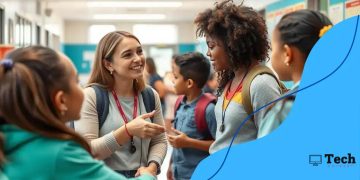Culturally inclusive curriculum reforms: why they matter

Culturally inclusive curriculum reforms integrate diverse perspectives into education, fostering empathy, respect, and collaboration among students from various backgrounds while enhancing their academic performance and social skills.
Culturally inclusive curriculum reforms play a vital role in shaping education today. Have you ever wondered how they can foster a more equitable learning environment? Let’s dive into their importance.
Understanding culturally inclusive curriculum
Understanding culturally inclusive curriculum is essential for creating a learning environment where all students feel valued. This type of curriculum recognizes and celebrates students’ diverse backgrounds, helping to foster their academic and social growth.
A culturally inclusive curriculum works to integrate the perspectives, histories, and contributions of various cultural groups. For example, it can highlight authors from diverse backgrounds in literature classes or include historical events from multiple viewpoints in social studies. Such exposure helps students build a better understanding of the world around them.
Key Principles of Culturally Inclusive Curriculum
There are several important principles that guide the development of an inclusive curriculum:
- Respect for different cultural perspectives
- Engagement of families and communities in the educational process
- Encouragement of critical thinking through diverse viewpoints
Implementing these principles can enhance student engagement and success. Additionally, it prepares students to thrive in our increasingly diverse society. When students learn about different cultures and perspectives, they become more empathetic and open-minded.
Another vital aspect of a culturally inclusive curriculum is its adaptability. It should be responsive to the needs of the students it serves. By regularly evaluating and updating the curriculum, educators can ensure that it remains relevant and inclusive. This dynamic approach makes learning more engaging and meaningful.
Benefits for Students
By engaging with a culturally inclusive curriculum, students gain numerous benefits, such as:
- Increased motivation to learn
- Improved academic performance
- Enhanced social skills and empathy
These advantages not only support individual growth but also contribute to a more harmonious classroom environment. Ultimately, embracing different cultures leads to a richer educational experience for everyone involved.
Benefits for students and educators
Implementing a culturally inclusive curriculum brings many benefits for students and educators. These advantages enhance the learning environment and promote better educational outcomes.
For students, a culturally inclusive approach fosters a sense of belonging. When students see their cultures represented in the curriculum, they feel valued and included. This increases their engagement and motivation to learn. Furthermore, exposure to diverse perspectives allows students to develop critical thinking skills and adapt to a multicultural world.
Key Benefits for Students
Understanding the benefits can help highlight the importance of inclusivity in education:
- Improved Academic Performance: Engaging with diverse materials can enhance understanding and retention.
- Enhanced Social Skills: Students learn to collaborate with peers from different backgrounds, which improves teamwork.
- Increased Empathy: Exposure to various cultures promotes understanding and respect for differences.
Equally important, educators also benefit from implementing a culturally inclusive curriculum. It enriches their teaching experience and makes the classroom more dynamic.
Advantages for Educators
For teachers, using an inclusive approach can lead to the following:
- Professional Development: Educators gain insights into various teaching methods and cultural perspectives.
- Stronger Relationships: Building connections with students based on mutual respect enhances classroom management.
- Enhanced Creativity: Incorporating diverse content allows teachers to develop creative lesson plans.
Educators who embrace inclusivity often feel more fulfilled in their roles, leading to higher job satisfaction. As a result, this creates a positive classroom atmosphere that benefits everyone involved.
Strategies for effective implementation

When it comes to strategies for effective implementation of a culturally inclusive curriculum, planning and collaboration are key. Schools need to consider the unique needs of their students while incorporating diverse cultures into their teaching.
One important strategy is to involve the community in the curriculum development process. Engaging parents, local leaders, and cultural organizations can provide valuable insights. This collaboration helps to ensure that the curriculum reflects the community’s diversity and promotes inclusiveness.
Developing Inclusive Pedagogies
Another effective approach is to create inclusive pedagogies. This means using teaching methods that cater to different learning styles, allowing all students to thrive. For example, incorporating visual aids, group activities, and discussions can enhance engagement and understanding. By recognizing varied learning needs, educators can create a more equitable classroom.
- Incorporate Diverse Materials: Use texts and resources from various cultural backgrounds.
- Adapt Teaching Styles: Be flexible in teaching approaches to meet students’ needs.
- Foster Collaborative Learning: Encourage teamwork and sharing of ideas among students.
Training teachers on cultural competency is also crucial. Professional development programs focused on diversity can help educators understand their biases and learn strategies to support all students. Continued education on this topic ensures that teachers are equipped with the knowledge they need to build an inclusive environment.
Assessment and Feedback
Regularly assessing the effectiveness of the curriculum is essential. Schools should collect feedback from students and families to evaluate how well the curriculum meets its goals. This information can guide necessary adjustments and improvements. When schools remain open to feedback, they can better serve their students.
Finally, celebrating cultural events and achievements in the classroom helps reinforce a sense of community. This not only promotes awareness but also encourages students to take pride in their backgrounds. All these strategies work together to create a rich, inclusive educational experience.
Challenges in curriculum reform
While implementing a culturally inclusive curriculum offers numerous benefits, it also presents several challenges that educators and institutions must navigate. Understanding these obstacles is crucial for effective reform.
One major challenge is resistance to change. Many educators and stakeholders may be set in their traditional teaching methods. They might not fully understand the importance of cultural inclusivity. Overcoming this resistance requires ongoing training and open dialogues about the benefits of a diverse curriculum.
Institutional Barriers
Another significant hurdle involves institutional barriers. Some schools may have rigid curricular standards that limit flexibility. This can make it difficult to integrate diverse perspectives into the existing framework. It’s essential for educational leaders to advocate for policies that support adaptability within the curriculum.
- Budget Constraints: Limited funding can restrict access to diverse materials and resources.
- Curriculum Overload: Teachers may feel overwhelmed with existing curricula, making it hard to incorporate new elements.
- Lack of Resources: Schools might not have adequate teaching materials that represent various cultures.
Additionally, another challenge is ensuring proper training for educators. Teachers need the skills and knowledge to effectively teach a culturally inclusive curriculum. Without this training, educators may lack confidence in covering diverse topics, leading to a less effective learning experience for students.
Community Engagement
Building community support is also essential, yet challenging. Parents and community members may not always agree on the importance of cultural inclusivity in schools. Establishing partnerships with families and local organizations can help bridge this divide, fostering a united front supporting the curriculum reforms.
Finally, assessing the impact of such reforms can be complex. Evaluating whether a culturally inclusive curriculum is successful often requires new methods and metrics. Schools must be prepared to adapt their assessment practices to accurately reflect student learning and engagement.
Real-world examples of inclusive education
Real-world examples of inclusive education provide valuable insights into how schools can effectively implement a culturally inclusive curriculum. These examples showcase the positive impact such programs can have on students and educators alike.
One notable example is a school in a diverse urban area that has embraced a multicultural curriculum. They incorporate stories, histories, and traditions from various cultures into their lessons. Students take part in projects where they research and present on different cultural celebrations throughout the year. This not only broadens their understanding of the world but also helps build empathy and respect among peers.
Inclusive Practices
Another effective practice comes from a school that utilizes cooperative learning strategies. In this environment, students from different backgrounds work in mixed groups. They tackle projects together, sharing their unique perspectives and insights. This collaboration fosters an inclusive atmosphere where every student’s voice is heard.
- Diverse Literature: The school library features books from various cultures, reflecting the backgrounds of the students.
- Cultural Awareness Days: Students participate in events that celebrate their heritage, improving community engagement.
- Parent Involvement: Schools actively involve parents in curriculum development, ensuring diverse viewpoints are represented.
A further example can be seen in a district-wide initiative aimed at staff training. Teachers attend workshops focused on cultural competency and inclusive practices. This helps educators become more aware of their biases and equipped with effective strategies to support all students. Training sessions often include guest speakers from various communities, adding depth to the learning experience.
Benefits Seen in Classrooms
Schools implementing inclusive education see significant benefits. For instance, students demonstrate improved academic performance and increased engagement. They feel more connected to their classmates and school community, leading to lower dropout rates. Additionally, educators report higher job satisfaction due to the positive and supportive learning environment.
These real-world examples highlight the potential of a culturally inclusive curriculum. They show that when students and educators embrace diversity, everyone benefits. Schools play a critical role in shaping the future by promoting inclusivity and understanding in their classrooms.
Adopting a culturally inclusive curriculum is essential for creating a learning environment where all students feel valued and understood. It encourages empathy, respect, and collaboration among students from diverse backgrounds. As we’ve seen from various schools implementing inclusive practices, the benefits extend to both students and educators. With the proper strategies and community involvement, challenges can be addressed effectively. By celebrating diversity in our classrooms, we prepare students for a more inclusive world and foster a sense of belonging for everyone. Let’s continue to advocate for inclusive education and ensure that every student’s voice is heard and respected.
FAQ – Frequently Asked Questions about Culturally Inclusive Curriculum
What is a culturally inclusive curriculum?
A culturally inclusive curriculum integrates diverse cultural perspectives and teaching materials, helping all students feel valued and understood.
How can a culturally inclusive curriculum benefit students?
It promotes empathy, respect, and collaboration among students, improving their social skills and academic performance.
What are some challenges in implementing an inclusive curriculum?
Challenges include resistance to change, limited resources, and the need for proper training for educators.
How can schools involve the community in curriculum development?
Schools can engage parents and local organizations to provide input and support, ensuring diverse cultural perspectives are represented.






